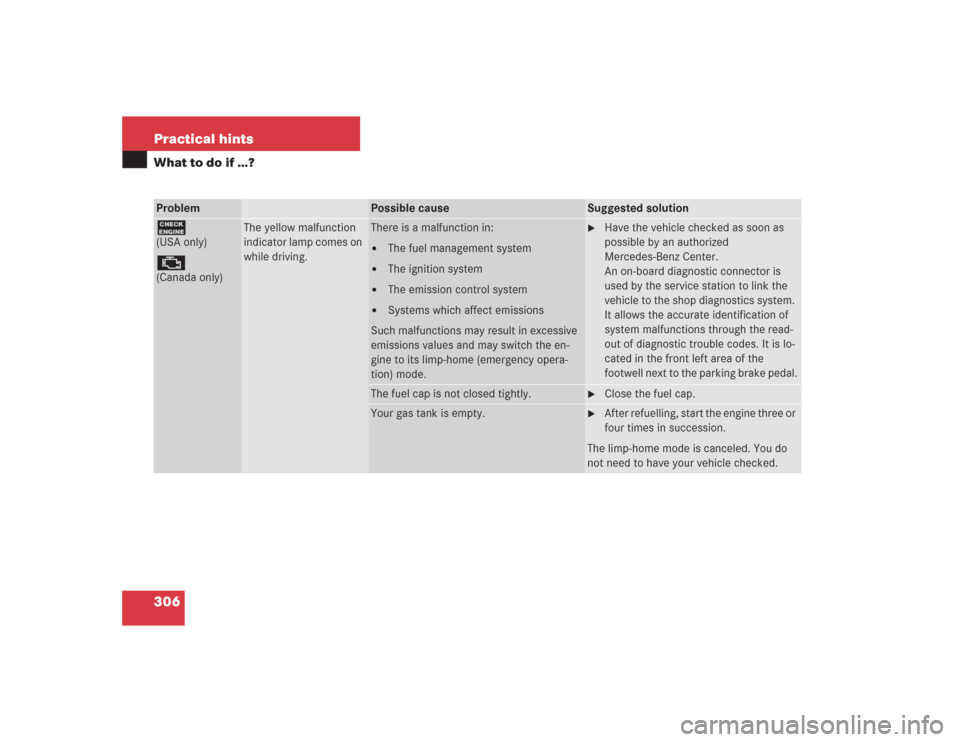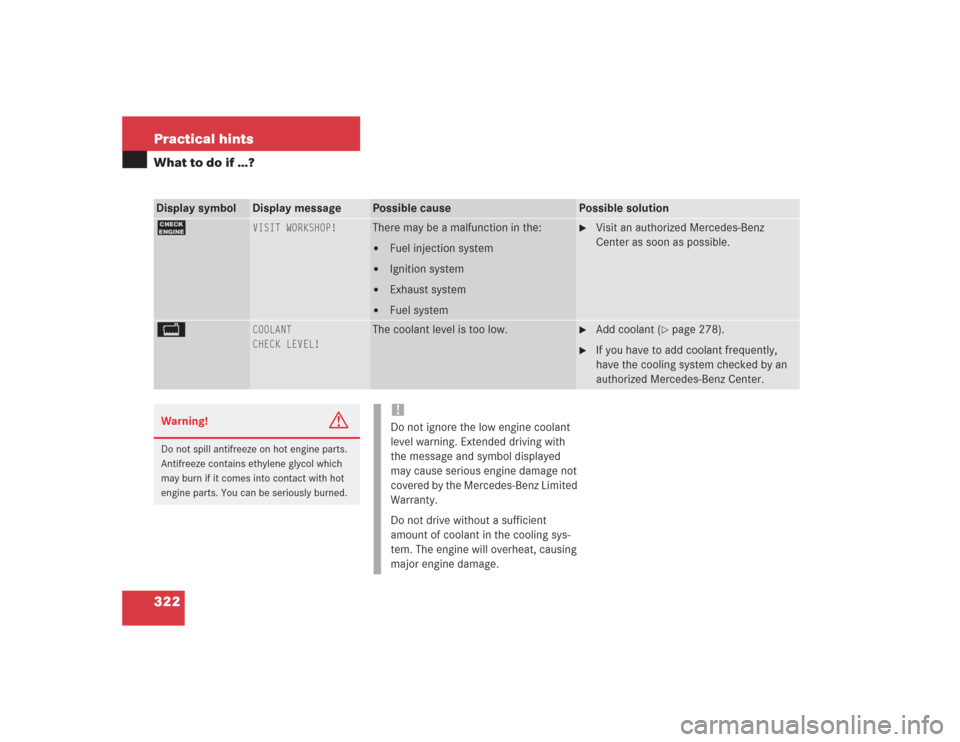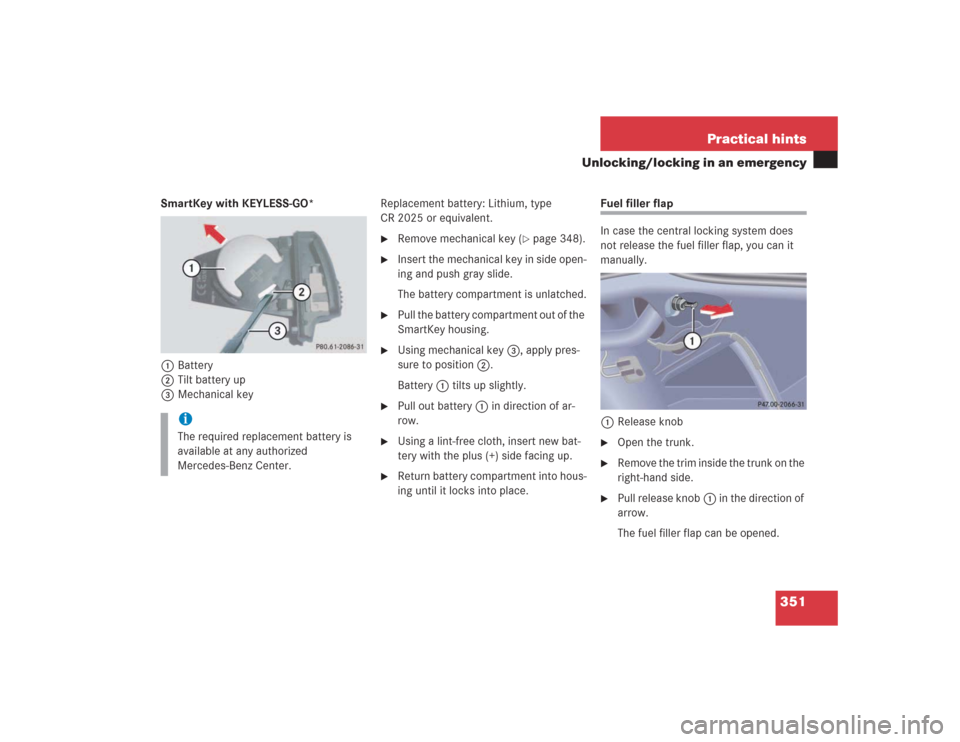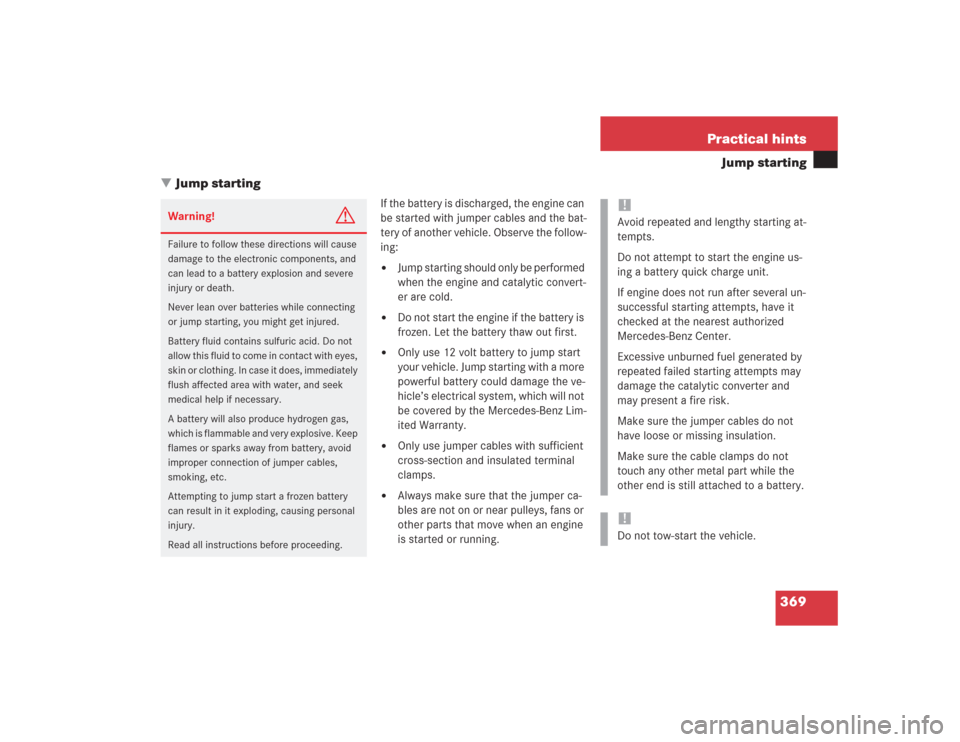Page 307 of 435

306 Practical hintsWhat to do if …?Problem
Possible cause
Suggested solution
?(USA only)±(Canada only)
The yellow malfunction
indicator lamp comes on
while driving.
There is a malfunction in:�
The fuel management system
�
The ignition system
�
The emission control system
�
Systems which affect emissions
Such malfunctions may result in excessive
emissions values and may switch the en-
gine to its limp-home (emergency opera-
tion) mode.
�
Have the vehicle checked as soon as
possible by an authorized
Mercedes-Benz Center.
An on-board diagnostic connector is
used by the service station to link the
vehicle to the shop diagnostics system.
It allows the accurate identification of
system malfunctions through the read-
out of diagnostic trouble codes. It is lo-
cated in the front left area of the
footwell next to the parking brake pedal.
The fuel cap is not closed tightly.
�
Close the fuel cap.
Your gas tank is empty.
�
After refuelling, start the engine three or
four times in succession.
The limp-home mode is canceled. You do
not need to have your vehicle checked.
Page 309 of 435
308 Practical hintsWhat to do if …?Problem
Possible cause
Suggested solution
v
The yellow ESP warning lamp
comes on while driving.
The ESP is deactivated.
Risk of accident!
Adapt your speed and driving to the prevail-
ing road, weather, and traffic conditions.
�
Switch the ESP back on (
�page 81).
If the ESP cannot be switched back on, have
the system checked at an authorized
Mercedes-Benz Center as soon as possible.
The yellow fuel tank reserve
warning lamp comes on while
driving.
The fuel level has gone below the reserve
mark.
�
Refuel at the next gas station
(�page 269).
<
The red seat belt telltale illumi-
nates for a brief period after
starting the engine.
The warning lamp reminds you to fasten
seat belts.
�
Fasten your seat belt.
The warning lamp goes out.
Page 310 of 435

309 Practical hints
What to do if …?
Problem
Possible cause
Suggested solution
H
The yellow warning lamp for the
tire pressure monitor comes on.
The tire pressure monitor detects a loss of
pressure in at least one tire.
�
Bring the vehicle to a halt, avoiding
abrupt steering and braking maneuvers.
Observe the traffic situation around you.
�
Take note of the messages in the multi-
function display.
Warning!
G
When the tire pressure monitoring system
warning lamp is lit, one or more of your tires
is significantly under-inflated. You should
stop and check your tires as soon as possi-
ble, and inflate them to the proper pressure
as indicated on the vehicle’s tire information
placard. Driving on a significantly under-in-
flated tire causes the tire to overheat and
can lead to tire failure.
Under-inflation also reduces fuel efficiency
and tire tread life, and may affect the vehi-
cle’s handling and stopping ability. Each tire,
including the spare, should be checked
monthly when cold and set to the recom-
mended inflation pressure as specified in
the vehicle placard and owner’s manual.
iThe recommended tire inflation pres-
sures for your vehicle can be found on
the inside of the fuel filler flap, not in
the owner’s manual.
Page 323 of 435

322 Practical hintsWhat to do if …?Display symbol
Display message
Possible cause
Possible solution
?
VISIT WORKSHOP!
There may be a malfunction in the:�
Fuel injection system
�
Ignition system
�
Exhaust system
�
Fuel system
�
Visit an authorized Mercedes-Benz
Center as soon as possible.
B
COOLANT
CHECK LEVEL!
The coolant level is too low.
�
Add coolant (
�page 278).
�
If you have to add coolant frequently,
have the cooling system checked by an
authorized Mercedes-Benz Center.
Warning!
G
Do not spill antifreeze on hot engine parts.
Antifreeze contains ethylene glycol which
may burn if it comes into contact with hot
engine parts. You can be seriously burned.
!Do not ignore the low engine coolant
level warning. Extended driving with
the message and symbol displayed
may cause serious engine damage not
covered by the Mercedes-Benz Limited
Warranty.
Do not drive without a sufficient
amount of coolant in the cooling sys-
tem. The engine will overheat, causing
major engine damage.
Page 327 of 435
326 Practical hintsWhat to do if …?Display symbol
Display message
Possible cause
Possible solution
:
USA only:ADD 1.0 QT. ENGINE
OIL
AT NEXT REFUELING!Canada only:ADD 1.0 LITER ENGINE
OIL
AT NEXT REFUELING!
The engine oil level is too low.
�
Add engine oil (
�page 277) and check
the engine oil level (�page 274).
ENGINE OIL LEVEL
STOP, ENGINE OFF!
There is no oil in the engine. There is a
danger of engine damage.
�
Carefully bring the vehicle to a halt as
soon as possible.
�
Turn off the engine.
�
Add engine oil (
�page 277) and check
the engine oil level (�page 274).
ENGINE OIL LEVEL
REDUCE OIL LEVEL
You have added too much engine oil.
There is a risk of damaging the engine or
the catalytic converter.
�
Have excess oil siphoned or drained off.
Observe all legal requirements with re-
spect to its disposal.
Page 328 of 435

327 Practical hints
What to do if …?
When the message
ADD 1.0 QT. ENGINE
OIL AT NEXT REFUELING!
(Canada:
1 Liter
) appears while the engine is run-
ning and at operating temperature, the en-
gine oil level has dropped to approximately
the minimum level.When this occurs, the warning will first
come on intermittently and then stay on if
the oil level drops further.
Visually check for oil leaks. If no obvious oil
leaks are noted, drive to the nearest ser-
vice station where the engine oil should be
topped to the required level with an ap-
proved oil.
Display symbol
Display message
Possible cause
Possible solution
:
ENGINE OIL
VISIT WORKSHOP!
It may be that there is water in the engine
oil.
�
Have the engine oil level checked
(�page 274).
ENGINE OIL LEVEL
VISIT WORKSHOP!
The engine oil has dropped to a critical
level.
�
Check the engine oil level (
�page 274)
and add engine oil as required
(
�page 277).
�
If you must add engine oil frequently,
have the engine checked for possible
leaks.
ENGINE OIL SENSOR
VISIT WORKSHOP!
The measuring system is malfunctioning.
�
Have the measuring system checked by
an authorized Mercedes-Benz Center.
!The engine oil level warnings should
not be ignored. Extended driving with
the symbol displayed could result in
serious engine damage that is not
covered by the Mercedes-Benz Limited
Warranty.
Page 352 of 435

351 Practical hints
Unlocking/locking in an emergency
SmartKey with KEYLESS-GO*
1Battery
2Tilt battery up
3Mechanical keyReplacement battery: Lithium, type
CR 2025 or equivalent.
�
Remove mechanical key (
�page 348).
�
Insert the mechanical key in side open-
ing and push gray slide.
The battery compartment is unlatched.
�
Pull the battery compartment out of the
SmartKey housing.
�
Using mechanical key3, apply pres-
sure to position2.
Battery1 tilts up slightly.
�
Pull out battery1 in direction of ar-
row.
�
Using a lint-free cloth, insert new bat-
tery with the plus (+) side facing up.
�
Return battery compartment into hous-
ing until it locks into place.
Fuel filler flap
In case the central locking system does
not release the fuel filler flap, you can it
manually.
1Release knob�
Open the trunk.
�
Remove the trim inside the trunk on the
right-hand side.
�
Pull release knob1 in the direction of
arrow.
The fuel filler flap can be opened.
iThe required replacement battery is
available at any authorized
Mercedes-Benz Center.
Page 370 of 435

369 Practical hints
Jump starting
�Jump starting
If the battery is discharged, the engine can
be started with jumper cables and the bat-
tery of another vehicle. Observe the follow-
ing:�
Jump starting should only be performed
when the engine and catalytic convert-
er are cold.
�
Do not start the engine if the battery is
frozen. Let the battery thaw out first.
�
Only use 12 volt battery to jump start
your vehicle. Jump starting with a more
powerful battery could damage the ve-
hicle’s electrical system, which will not
be covered by the Mercedes-Benz Lim-
ited Warranty.
�
Only use jumper cables with sufficient
cross-section and insulated terminal
clamps.
�
Always make sure that the jumper ca-
bles are not on or near pulleys, fans or
other parts that move when an engine
is started or running.
Warning!
G
Failure to follow these directions will cause
damage to the electronic components, and
can lead to a battery explosion and severe
injury or death.
Never lean over batteries while connecting
or jump starting, you might get injured.
Battery fluid contains sulfuric acid. Do not
allow this fluid to come in contact with eyes,
skin or clothing. In case it does, immediately
flush affected area with water, and seek
medical help if necessary.
A battery will also produce hydrogen gas,
which is flammable and very explosive. Keep
flames or sparks away from battery, avoid
improper connection of jumper cables,
smoking, etc.
Attempting to jump start a frozen battery
can result in it exploding, causing personal
injury.
Read all instructions before proceeding.
!Avoid repeated and lengthy starting at-
tempts.
Do not attempt to start the engine us-
ing a battery quick charge unit.
If engine does not run after several un-
successful starting attempts, have it
checked at the nearest authorized
Mercedes-Benz Center.
Excessive unburned fuel generated by
repeated failed starting attempts may
damage the catalytic converter and
may present a fire risk.
Make sure the jumper cables do not
have loose or missing insulation.
Make sure the cable clamps do not
touch any other metal part while the
other end is still attached to a battery.!Do not tow-start the vehicle.